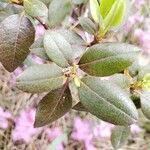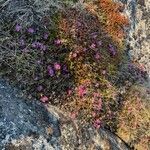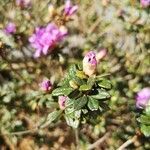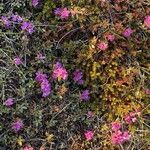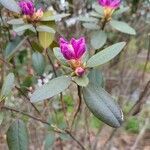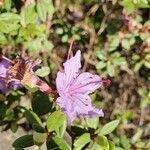Small, much-branched prostrate or erect shrubs, 0.2–0.45(–1) m tall. Petiole 1.5–4 mm, scaly; leaf blade oblong-elliptic, ovate-elliptic to oblong-obovate, 0.4–1.5(–2.5) × 0.2–0.5(–0.9) cm; base broadly cuneate; apex obtuse or rounded, mucronate; abaxial surface fawn to reddish brown, scales contiguous or overlapping, 2-colored, pale brown or ferruginous, nearly equal in number and intermixed; adaxial surface pale green, matt, densely scaly. Inflorescence (2–)3–5(–6)-flowered. Pedicel 0.3–1.2 cm, scaly; calyx reddish or purple; lobes (0.5–) 1–2 mm, deltoid or rounded, persistent in fruit, scaly, margin ciliate and rarely scaly; corolla broadly funnelform, violet rose to purple or rarely white, (0.65–)0.7–1.3(–1.6) cm, tube (1.5–) 2–5(–6) mm, outer surface glabrous, throat pubescent; stamens 5–10, filaments pubescent towards base; ovary ca. 1.2 mm, densely scaly; style 1.1–1.5 cm, longer than stamens, glabrous. Capsule cylindric-ovate, 3–6 mm, densely scaly. Fl. May–Jul, fr. Sep–Oct.
Freely branched low shrub 1–3 dm, sometimes depressed and forming loose mats; lvs leathery, evergreen, elliptic, 10–15 mm, densely lepidote, especially beneath; fls few in a terminal, umbel-like cluster, bright purple, campanulate, 1.5 cm wide; stamens 5–10; fr 5 mm; 2n=26, 52. Circumboreal, s. to the higher mts. of N. Engl. and N.Y., and rarely to c. Wis. June.
A shrub. It is erect or can lie over. It has many branches. It grows 30 cm high. It keeps its leaves throughout the year. The leaves are leathery and dark green above but rusty coloured with hairs underneath. The flowers are purple and have a faint scent.
